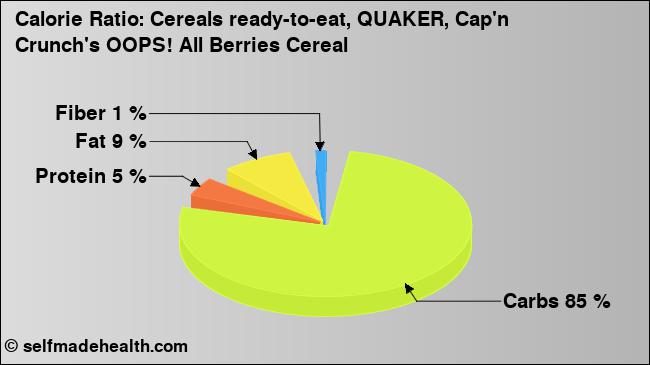Nutrition values of Cereals ready-to-eat, QUAKER, Cap'n Crunch's OOPS! All Berries Cereal
according to USDA Food Composition Database Standard Reference 04.2018
Not the right food? Find other foods
The following nutrition values are sourced from: USDA Food Composition Database Standard Reference 04.20181.
Nutrition values
Amount per 100g (edible portion)
Nutrition Facts
Nutrition Facts
Amount per 100g (edible portion)
Daily Value %*
Nutrition Facts
Fat
3.99
ggram
Fatty acids, total saturated
2.291
ggram
Fatty acids, total monounsaturated
0.593
ggram
Fatty acids, total polyunsaturated
0.764
ggram
Carbohydrates
87.10
ggram
Sugarstotal
44.18
ggram
Dietary fibertotal dietary fiber
2.6
ggram
Protein
4.60
ggram
Vitamin Ctotal ascorbic acid
CalciumCa
MagnesiumMg
SodiumNa
637
mgmiligram
Detailed Values
Energy
Amount per 100g (edible portion)
Daily Value %*
Energytotal energy
395
kcalkilocalorie
Energytotal energy
1653
kjkilojoule
Carbohydrates
Amount per 100g (edible portion)
Daily Value %*
Carbohydrates
87.10
ggram
Sugarstotal
44.18
ggram
Dietary fibertotal dietary fiber
2.6
ggram
Fat
Amount per 100g (edible portion)
Daily Value %*
Fat
3.99
ggram
Fatty acids, total saturated
2.291
ggram
Fatty acids, total monounsaturated
0.593
ggram
Fatty acids, total polyunsaturated
0.764
ggram
Fatty acids, total trans
0.013
ggram
Vitamins
Amount per 100g (edible portion)
Daily Value %*
Vitamins
Vitamin A
150
iuinternational units
Thiamin
RiboflavinVitamin B-2
NiacinVitamin B-3
23.961
mgmiligram
Vitamin B-6
FolateIncludes folate from food plus folic acid
1353
μgmicrogram
Vitamin B-12Cobalamin
Vitamin Ctotal ascorbic acid
Vitamin E
Alpha-Tocopherol
An empty value in the table means that no value is available and nothing is being said about it. 0 / 0.0 / 0.000 means that the nutrient is not contained at all or only in slight amounts.
The table above contains values from the following nutrition databases.
Notices
* Calculating the percentages of daily intake are for a 45 year old person and the average of man and woman. For the calculation the recommended dietary allowance (RDA) is used and, if not available, estimates of adequate intake (AI) or estimates of average requirement (EAR) are used.
** Calculated with the following factors: carbohydrates 4 kcal/g, proteins 4 kcal/g, fat 9 kcal/g, fibers 2 kcal/g, alcohol 7 kcal/g.
Sources
1
US Department of Agriculture. Agricultural Research Service. (2018). USDA National Nutrient Database for Standard Reference, Legacy (2018). Retrieved from https://ndb.nal.usda.gov/ndb/ at 2018-12-18.
